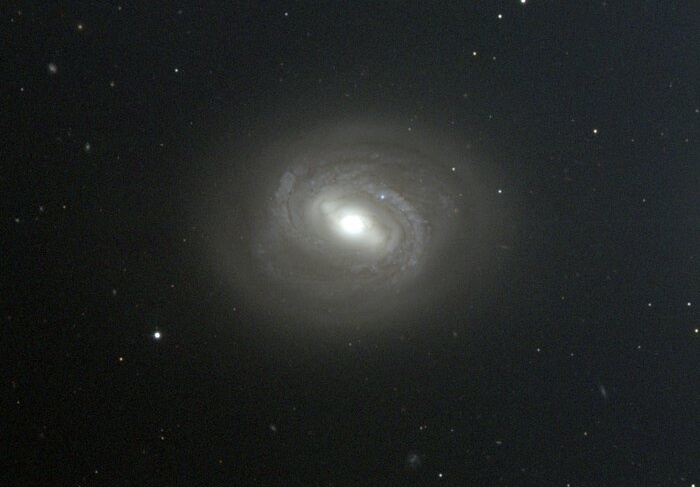M58 (Messier 58), also known as NGC 4579, is a barred spiral galaxy located in the constellation Virgo. It is one of the brighter members of the Virgo Cluster of galaxies and is notable for its active galactic nucleus (AGN).
Structure and Features
M58 is about about 110,000 light-years in diameter and approximately 62 million light years away from earth. It has a well-defined central bar structure from which its spiral arms emanate. This bar structure is common in many spiral galaxies and influences star formation within the galaxy. Bars are thought to drive gas towards the center of galaxies, potentially fueling star formation and feeding central black holes.
M58 hosts a LINER (Low-Ionization Nuclear Emission-line Region) nucleus. This type of active galactic nucleus emits weakly ionized gas and suggests the presence of a supermassive black hole at its center, although it is less active compared to other types of AGNs.
The galaxy shows regions of active star formation, particularly in its spiral arms. These regions can be identified by their bright, blue stars and HII regions (clouds of ionized hydrogen).
Observational History
M58 was discovered by Charles Messier on April 15, 1779, during his search for comet-like objects. Since then it has been studied extensively due to its membership in the Virgo Cluster and its interesting barred spiral structure. It was one of the first galaxies recognized to have a barred spiral structure.
As a member of the Virgo Cluster, M58 provides valuable insights into the dynamics and interactions of galaxies within a large cluster. Studying such galaxies helps astronomers understand the role of environment in galactic evolution.

Observing the galaxy
The best time to observe M58 is during the spring months when the constellation Virgo is high in the sky, particularly from March to May. M58 is located within the Virgo Cluster, which lies between the constellations Virgo and Coma Berenices. It can be found roughly 10 degrees west of the star Vindemiatrix (Epsilon Virginis).
M58 is primarily a target for observers in the Northern Hemisphere, but it is also visible in the Southern Hemisphere from locations closer to the equator during it’s autumn season.
The galaxy can be observed with medium to large amateur telescopes. It appears as a faint, elongated object, with its bar and spiral structure becoming more apparent with larger apertures under dark-sky conditions. A telescope with at least 8 inches (200 mm) of aperture is recommended to view M58 effectively.
Observing from a location with minimal light pollution will greatly enhance your ability to see the details of M58.



